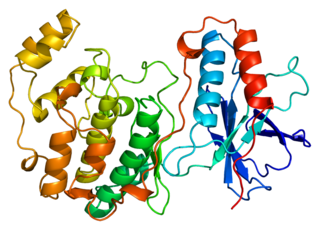Related Research Articles

Mitogen-activated protein kinase 9 is an enzyme that in humans is encoded by the MAPK9 gene.
p38 mitogen-activated protein kinases are a class of mitogen-activated protein kinases (MAPKs) that are responsive to stress stimuli, such as cytokines, ultraviolet irradiation, heat shock, and osmotic shock, and are involved in cell differentiation, apoptosis and autophagy. Persistent activation of the p38 MAPK pathway in muscle satellite cells due to ageing, impairs muscle regeneration.

RAF kinases are a family of three serine/threonine-specific protein kinases that are related to retroviral oncogenes. The mouse sarcoma virus 3611 contains a RAF kinase-related oncogene that enhances fibrosarcoma induction. RAF is an acronym for Rapidly Accelerated Fibrosarcoma.

Mitogen-activated protein kinase 1, also known as MAPK1, p42MAPK, and ERK2, is an enzyme that in humans is encoded by the MAPK1 gene.

Mitogen-activated protein kinase 14, also called p38-α, is an enzyme that in humans is encoded by the MAPK14 gene.

Mitogen-activated protein kinase 3, also known as p44MAPK and ERK1, is an enzyme that in humans is encoded by the MAPK3 gene.

Mitogen-activated protein kinase 8 is a ubiquitous enzyme that in humans is encoded by the MAPK8 gene.

Dual specificity mitogen-activated protein kinase kinase 1 is an enzyme that in humans is encoded by the MAP2K1 gene.

Mitogen-activated protein kinase 7 also known as MAP kinase 7 is an enzyme that in humans is encoded by the MAPK7 gene.

Dual specificity protein phosphatase 1 is an enzyme that in humans is encoded by the DUSP1 gene.

Dual specificity mitogen-activated protein kinase kinase 6 also known as MAP kinase kinase 6 or MAPK/ERK kinase 6 is an enzyme that in humans is encoded by the MAP2K6 gene, on chromosome 17.

Dual specificity mitogen-activated protein kinase kinase 3 is an enzyme that in humans is encoded by the MAP2K3 gene.

Mitogen-activated protein kinase kinase kinase 11 is an enzyme that in humans is encoded by the MAP3K11 gene.

Activating transcription factor 2, also known as ATF2, is a protein that, in humans, is encoded by the ATF2 gene.

Ribosomal protein S6 kinase alpha-2 is an enzyme that in humans is encoded by the RPS6KA2 gene.

Mitogen-activated protein kinase kinase kinase 7-interacting protein 1 is an enzyme that in humans is encoded by the TAB1 gene.

Dual specificity mitogen-activated protein kinase kinase 5 is an enzyme that in humans is encoded by the MAP2K5 gene.

Mitogen-Activated Protein Kinase Kinase Kinase 2 also known as MEKK2 is an enzyme that in humans is encoded by the MAP3K2 gene.

Mitogen-activated protein kinase 11 is an enzyme that in humans is encoded by the MAPK11 gene.
Candidalysin is a cytolytic 31-amino acid α-helical amphipathic peptide toxin secreted by the opportunistic pathogen Candida albicans. This toxin is a fungal example of a classical virulence factor. Hyphal morphogenesis in C. albicans is associated with damage to host epithelial cells; during this process Candidalysin is released and intercalates in host membranes. Candidalysin promotes damage of oral epithelial cells and induces lactate dehydrogenase release and calcium ion influx. It is unique in the fact that it is the first peptide toxin to be identified in any human fungal pathogen.